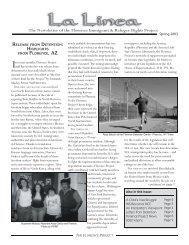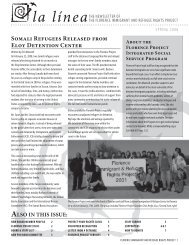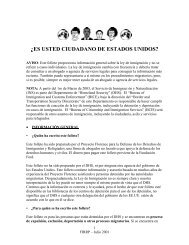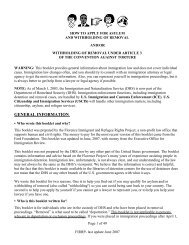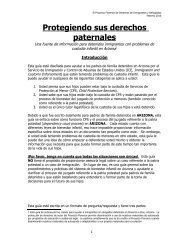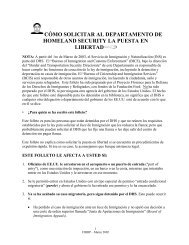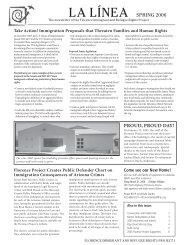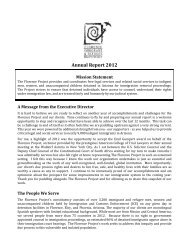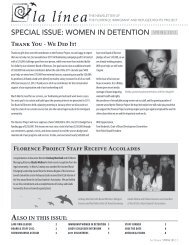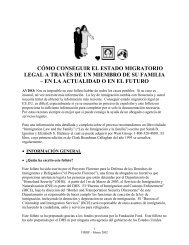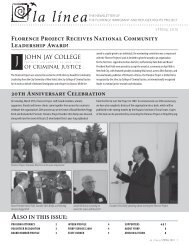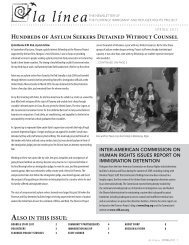quick reference chart and annotations for determining immigration ...
quick reference chart and annotations for determining immigration ...
quick reference chart and annotations for determining immigration ...
Create successful ePaper yourself
Turn your PDF publications into a flip-book with our unique Google optimized e-Paper software.
Immigrant Legal Resource Center, Florence Immigrant <strong>and</strong> Refugee Rights Project,<br />
Maricopa County Public Defender August 2012<br />
11. Assault, ARS § 13-1203<br />
A. A person commits assault by:<br />
1. Intentionally, knowingly or recklessly causing any physical injury to another person or<br />
2. Intentionally placing another person in reasonable apprehension of imminent physical injury or<br />
3. Knowingly touching another person with the intent to injure, insult or provoke such a person.<br />
B. Assault committed intentionally or knowingly pursuant to subsection A, paragraph 1 is a class 1<br />
misdemeanor. Assault committed recklessly pursuant to subsection A, paragraph 1 or assault pursuant to<br />
subsection A, paragraph 2 is a class 2 misdemeanor. Assault committed pursuant to subsection A,<br />
paragraph 3 is a class 3 misdemeanor.<br />
Crime Involving Moral Turpitude: Possibly if A1 is coupled with §13-3601 <strong>and</strong> convicted as a<br />
class 1 misdemeanor. In general, simple assault is not a CMT. Matter of re Fualaau, 21 I&N Dec. 475<br />
(BIA 1996) (simple assault not CMT because statute only required bodily injury rather than serious<br />
bodily injury). However, in Fern<strong>and</strong>ez-Ruiz v. Gonzales, 468 F.3d 1159, 1165 (9th Cir. 2006), the Ninth<br />
Circuit found that a simple assault, if committed “willfully” against a person with whom the defendant<br />
has a domestic relationship <strong>and</strong> if resulting in “serious bodily injury,” would constitute a CMT. See also<br />
Grageda v. INS, 12 F.3d 919, 922 (9th Cir. 1993). The Ninth Circuit has exp<strong>and</strong>ed this holding to find<br />
that intentional assault that wounds, maims, disfigures, or endangers the life of another is categorically a<br />
CMT. See Uppal v. Holder, 576 F.3d 1014 (9th Cir. 2009). Since A1 as a class 1 misdemeanor carries a<br />
mens rea of intent pursuant to § 13-1203(B), the government may argue that it is a CMT. However,<br />
<strong>immigration</strong> counsel can counter that A1 is overbroad since it requires “any physical injury” rather than<br />
“serious bodily injury.” If the noncitizen must accept a class 1 misdemeanor, counsel should keep<br />
evidence of any “serious bodily injury” out of the record of conviction.<br />
A conviction <strong>for</strong> A2 or A3 coupled with a <strong>reference</strong> to 13-3601 could also be a CMT if the record<br />
of conviction demonstrates that there was “serious bodily injury.” Though the statuory language of A2<br />
<strong>and</strong> A3 make it unlikely that this would be part of the factual basis, defense counsel should strike any<br />
mention of “serious bodily injury” from the record of conviction.<br />
The Ninth Circuit has held that “a relationship of trust” must be present in order <strong>for</strong> simple<br />
assault to rise to the level of a CMT. Morales-Garcia v. Holder, 567 F.3d 1058, 1065 (9th Cir. 2009).<br />
Simple assault committed against persons other than a spouse (such as <strong>for</strong>mer cohabitants or people who<br />
are more akin to strangers or acquaintances) does not trigger a CMT. Id. at 1065-66. Since ARS § 13-<br />
3601 includes <strong>for</strong>mer cohabitants, relatives outside of the immediate family, <strong>and</strong> in-laws, mere conviction<br />
of DV assault may be insufficient to constitute a CMT. Counsel should specify the defendant’s<br />
relationship to the victim if it is outside of the immediate family <strong>and</strong> leave the relationship vague if it is a<br />
spouse or child (remember, however, that any conviction defined as domestic violence by a state statute<br />
will be removable under the DV ground of deportability)<br />
Aggravated Felony: Crime of Violence. To be an aggravated felony the conviction must be a<br />
crime of violence. Neither A3, nor recklessly causing physical injury under A1, is categorically a crime<br />
of violence. Flores-Lopez v. Holder, 685 F.3d 857 (9th Cir. 2012) (Cali<strong>for</strong>nia “general intent” crime that<br />
employs a mens rea of recklessness is not categorically a “crime of violence” under section 16(b)).<br />
However, a conviction under A2 will be a crime of violence. Camacho-Cruz v. Holder, 621 F.3d 941, 943<br />
(9th Cir. 2010) (“intentionally placing another person in reasonable apprehension of immediate bodily<br />
harm” is a crime of violence). See discussion at Other Grounds: Domestic Violence, below.<br />
Note that a plea to attempted assault will always involve an intentional mens rea <strong>and</strong> thus<br />
preclude the benefits of a plea to recklessness. United States v. Gomez-Hern<strong>and</strong>ez, 680 F.3d 1171, 1176<br />
Arizona Criminal Chart with Explanatory Endnote – August 2012<br />
23



